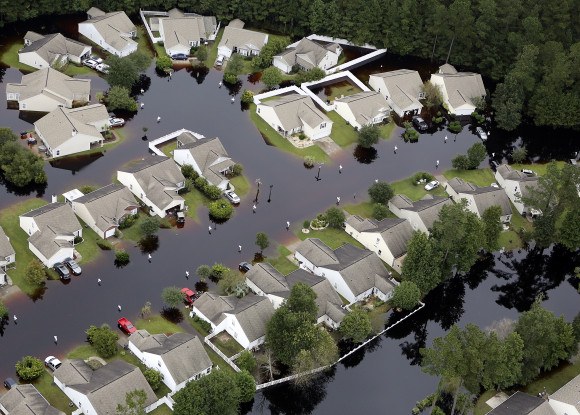The Trump administration is sitting on billions of dollars intended to help vulnerable cities and states prepare for extreme weather, prompting growing criticism from state officials worried about the next storm season.
In February, following a string of severe natural disasters in 2017, Congress provided a record $16 billion for disaster mitigation — building better defenses against hurricanes, floods and other catastrophes.
Eleven months later, the administration has yet to issue rules telling states how to apply for the money. On Wednesday, Texas, which stands to get more than $4 billion, sent a letter to President Donald Trump’s budget director, Mick Mulvaney, asking him to break the logjam.
“We cannot afford to wait any longer,” wrote George P. Bush, commissioner of the state’s General Land Office, which is overseeing the recovery from the hurricane that slammed into Houston and Southeast Texas in August 2017. “Please approve these rules for publication as soon as possible so we can get started on construction of vital infrastructure projects to protect Texans from the type of damage caused by Hurricane Harvey.”
Longstanding Complaint
A spokeswoman for the White House’s Office of Management and Budget didn’t respond to a request for comment, nor did a spokesman for the Department of Housing and Urban Development, which administers the disaster funds.
The partial federal government shutdown further complicates the process, since staff who must approve the rules that govern the funds are furloughed. But the problem existed before the shutdown, said Brittany Eck, a spokeswoman for the Texas General Land Office.
The $16 billion in funds was meant to address a longstanding complaint about U.S. disaster policy: instead of spending money to protect communities before a storm, the government typically releases funding only after damage has happened. Yet a federally-funded study in 2018 found that every $1 spent on mitigation saves $6 on future disaster costs.
Climate change is causing federal disaster costs to increase. Extreme weather cost the federal government more than $350 billion over the past decade, according to the U.S. Government Accountability Office, an amount that’s expected to increase as rising temperatures lead to more intense and more frequent storms.
Inadequate Staffing
But the influx of new money in 2018 has illustrated a second complaint: the process for getting disaster money to places that need it is long and cumbersome. And as the amount of funding increases, the career staff assigned to process those funds hasn’t kept pace, according to former HUD officials.
In Puerto Rico, which is due to receive $8.3 billion of the funding, Housing Secretary Fernando Gil blamed the delay on inadequate federal staffing. “HUD were not prepared with the amount of personnel necessary to meet the magnitude of the emergency,” he said in an interview in December.
The government has never taken so long to process this type of funding, said Marion McFadden, deputy assistant secretary for grant programs at HUD until 2016.
As Time Goes By
“In the more than 15 years I have been working on disaster recovery, I’ve never seen so much time go by between HUD’s announcement of funding awards to specific jurisdictions and publication of the rules that allow a state to use the dollars,” McFadden, who is now senior vice president at Enterprise Community Partners, said by email. “Communities are waiting for HUD and the White House to give them access to these urgently needed grants.”
HUD Secretary Ben Carson trumpeted the mitigation funding in April, when his department released a breakdown of how much money each jurisdiction would receive based on the extent of damage sustained in previous disasters. After Puerto Rico and Texas, the largest recipients are supposed to be Louisiana ($1.2 billion), the U.S. Virgin Islands ($774 million) and Florida ($550 million).
“These grants will help rebuild communities impacted by past disasters and will also protect them from major disasters in the future,” Carson said in a press release at the time.
Eck said HUD was right about the importance of that funding — and that’s why the state is worried. “We want to put these dollars to work,” she said in an interview. “Our message is, wherever it is, shake it loose.”





















 Executives on the Move at Liberty Mutual, Cowbell, W. R. Berkley
Executives on the Move at Liberty Mutual, Cowbell, W. R. Berkley  Artificial Intelligence Is Rewriting the Rules for Commercial Lines
Artificial Intelligence Is Rewriting the Rules for Commercial Lines  Surge of Supercharged Hurricanes Prompt Call for Cat 6 Classification
Surge of Supercharged Hurricanes Prompt Call for Cat 6 Classification  Why the Middle Market Matters and How Insurers Can Capture It
Why the Middle Market Matters and How Insurers Can Capture It 







